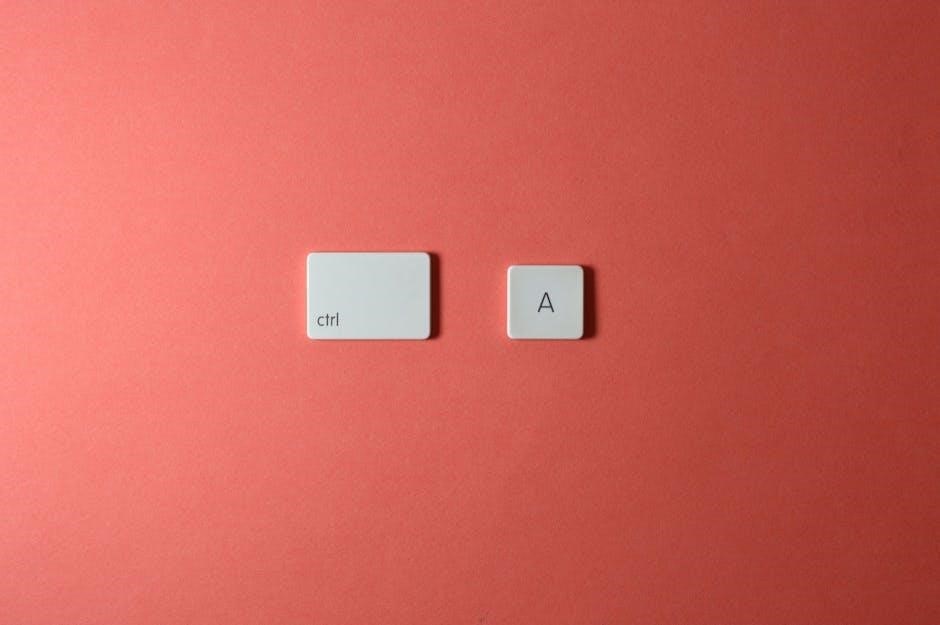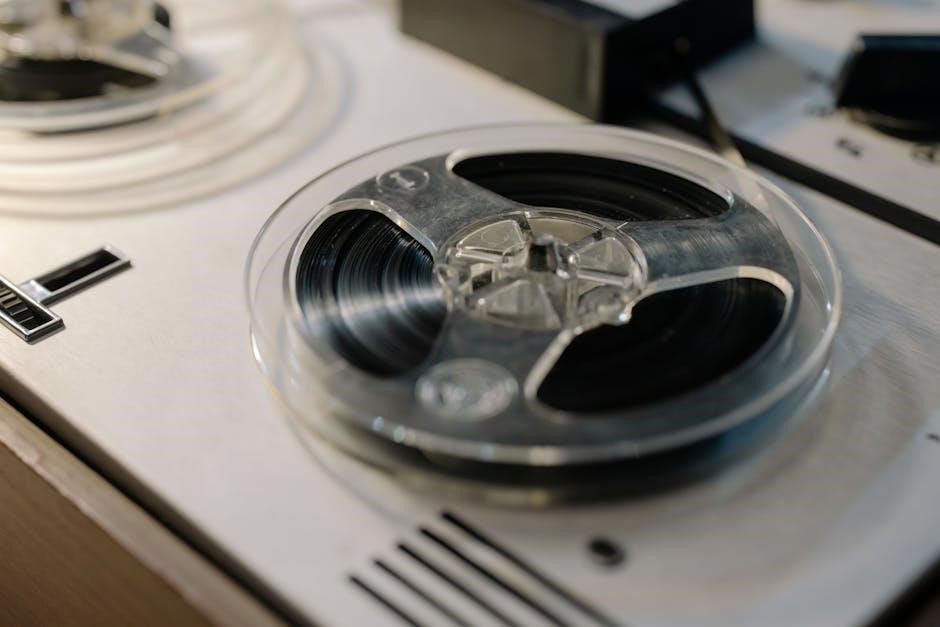
Canon Rebel T1i Instruction Manual Overview
The Canon Rebel T1i manual provides a comprehensive guide to understanding and utilizing the camera’s features, including HD video recording, DIGIC 4 processor, and 15.1 MP sensor.
Welcome to the Canon Rebel T1i, a high-performance DSLR camera designed for both beginners and advanced photographers. This camera offers a 15.1-megapixel CMOS sensor, DIGIC 4 Image Processor, and HD movie recording capabilities, making it a versatile tool for capturing stunning stills and videos. With its intuitive interface and advanced features, the Rebel T1i empowers users to explore their creativity and take control of their photography. This manual will guide you through the setup, features, and best practices to help you get the most out of your camera. Whether you’re shooting in auto mode or manually adjusting settings, this guide will help you master the Rebel T1i and unlock its full potential.
Key Features of the Canon Rebel T1i
The Canon Rebel T1i stands out with its 15.1-megapixel CMOS sensor, delivering crisp and detailed images. It features the DIGIC 4 Image Processor, ensuring fast operation and excellent image quality. The camera supports HD video recording at 1080p, making it suitable for videographers. With a 3.0-inch LCD screen, users can preview shots and navigate menus effortlessly. The Rebel T1i also offers various shooting modes, including Auto, Program, and Manual, catering to both beginners and advanced users. Additionally, it includes advanced autofocus modes and ISO settings up to 3200, providing flexibility in diverse lighting conditions. These features make the Rebel T1i a powerful and versatile choice for photographers seeking high-quality results.

Setting Up Your Canon Rebel T1i
Unpack and charge the battery, then insert the memory card. Mount the lens carefully and handle the camera with precision to ensure optimal performance and longevity.

Unpacking and Initial Setup
Begin by carefully unpacking the Canon Rebel T1i and its accessories, including the battery, charger, memory card, and lens. Inspect all items for damage or defects. Before first use, charge the battery fully using the provided charger. Insert the memory card into the camera, ensuring it clicks securely into place. Handle the camera and lens with care, avoiding touching the image sensor or lens surfaces. Familiarize yourself with the camera’s controls and ports, such as the LCD screen, mode dial, and memory card slot. Refer to the manual for proper handling techniques to maintain the camera’s performance and longevity. This initial setup ensures you’re ready to start capturing high-quality images and videos.
Charging the Battery and Inserting the Memory Card
Before using your Canon Rebel T1i, charge the battery using the provided charger. Plug the charger into a power outlet and attach the battery, ensuring it is properly aligned. Allow the battery to charge fully, which may take approximately 2 hours. Once charged, remove the battery from the charger and insert it into the camera’s battery compartment, located at the bottom of the camera. Secure the compartment door tightly. Next, insert a memory card into the card slot, located on the right side of the camera. Gently push the card until it clicks into place. Ensure the card is compatible with the camera and formatted correctly for optimal performance. Properly charging and installing the battery and memory card ensures your camera is ready for use.
Mounting the Lens and Basic Camera Handling
To mount the lens, ensure the camera is turned off. Align the lens mount with the camera’s lens mount, ensuring the white index markers match. Gently twist the lens clockwise until it clicks securely into place. For basic handling, hold the camera firmly with one hand on the grip and the other supporting the lens. Use the viewfinder or LCD screen to compose your shots. Familiarize yourself with the mode dial, shutter button, and control buttons for adjusting settings. Always use the neck strap for added security and portability. Handle the camera with care to avoid damage, especially the LCD screen and lens. Proper handling ensures optimal performance and longevity of your Canon Rebel T1i.

Understanding the Camera Modes
The Canon Rebel T1i offers various shooting modes, including Auto, Program, and Manual, allowing users to adjust settings for optimal control over their photography and HD video capture.
Auto Mode for Beginners
The Canon Rebel T1i’s Auto Mode is designed for beginners, allowing the camera to handle most settings automatically. This mode simplifies photography by adjusting aperture, shutter speed, and ISO for optimal results. It is ideal for those new to DSLR cameras, as it eliminates the need to understand complex settings. Auto Mode ensures well-balanced exposure and focus, making it perfect for everyday shooting scenarios.
Additionally, the T1i features Scene Intelligent Auto mode, which analyzes the scene and adjusts settings accordingly. This mode enhances the camera’s ability to capture vibrant and sharp images automatically. For beginners, Auto Mode provides a seamless transition into DSLR photography, allowing them to focus on composition and creativity while the camera manages technical details.

Program Mode (P)
Program Mode (P) on the Canon Rebel T1i offers a balance between automation and user control. The camera automatically sets the aperture and shutter speed to ensure proper exposure, but users can adjust these settings to suit their preferences. This mode is ideal for photographers who want more creative control than Auto Mode but still appreciate the camera’s assistance in achieving balanced exposure.
In Program Mode, you can adjust ISO, white balance, and other settings to fine-tune your photos. The camera’s DIGIC 4 Image Processor works to optimize image quality, ensuring vibrant colors and sharp details. Program Mode is a versatile option for everyday shooting, allowing you to experiment with creative adjustments while the camera handles the fundamentals of exposure. This mode is a stepping stone for photographers looking to transition from fully automatic to manual controls.
Manual Mode (M) for Advanced Users

Manual Mode (M) on the Canon Rebel T1i provides full control over all camera settings, allowing advanced users to customize exposure, aperture, shutter speed, and ISO. This mode is ideal for photographers who want precise control over their images, enabling them to achieve specific artistic effects or handle challenging lighting conditions. By adjusting the aperture and shutter speed independently, users can experiment with depth of field and motion effects.
The shutter speed is controlled using the dial next to the shutter release button, while the aperture is adjusted using the same dial when in Manual Mode. This mode also allows for customization of picture styles and white balance, giving photographers complete creative freedom. Manual Mode is perfect for those who have mastered the basics and are ready to push their photography skills to the next level, ensuring every shot meets their vision.

Focusing and Exposure Control
This section explains the Canon Rebel T1i’s autofocus modes, manual focus options, and exposure control features, helping users master sharp focus and precise light management for optimal images.
Autofocus Modes and Manual Focus
The Canon Rebel T1i offers multiple autofocus modes, including One-Shot AF, AI Servo AF, and AI Focus AF, each suited for different shooting scenarios. One-Shot AF is ideal for stationary subjects, while AI Servo AF is designed for tracking moving subjects. The camera also features manual focus, allowing precise control over focus settings. The manual focus can be accessed by switching the lens to MF mode and adjusting the focus ring. Additionally, the EOS Rebel T1i provides tools like AF point selection, enabling users to choose from 9 AF points for accurate subject tracking. These features ensure sharp images whether you’re capturing stills or Dynamic videos.
Understanding ISO Settings and Noise Reduction
The Canon Rebel T1i allows you to adjust ISO settings from 100 to 12800, providing flexibility in various lighting conditions. Lower ISOs (100-400) are ideal for bright environments to minimize noise, while higher ISOs (6400-12800) are better suited for low-light situations. However, higher ISOs may introduce digital noise, which can be managed using the camera’s noise reduction features. The T1i offers both Long Exposure Noise Reduction and High ISO Speed Noise Reduction, which can be enabled via the menu. These features help reduce grain in images, especially in low-light shots. Understanding and adjusting ISO settings and noise reduction options is crucial for achieving optimal image quality in different shooting scenarios, ensuring your photos are sharp and detailed without excessive noise.
Metering Modes and Exposure Compensation
The Canon Rebel T1i offers three metering modes: Evaluative, Center-Weighted, and Spot. Evaluative metering analyzes the entire scene to balance brightness and shadows, while Center-Weighted focuses on the central area with some peripheral consideration. Spot metering measures light from a small, selectable area, ideal for high-contrast scenes. Exposure compensation allows adjustments of ±2 stops in 1/3-stop increments, enabling fine-tuning of brightness to capture details in highlights or shadows. This feature is especially useful for correcting backlit subjects or adjusting for personal preference. Understanding and applying these metering modes and exposure compensation techniques ensures better control over image brightness and helps achieve the desired visual results in various lighting conditions.

Advanced Shooting Techniques
Explore advanced techniques like HD video recording, utilizing the DIGIC 4 processor for enhanced image quality, and mastering creative controls for versatile photography and videography experiences.
Using the Built-in Flash and External Speedlites
The Canon Rebel T1i features a built-in flash for convenient lighting in low-light conditions. For more advanced lighting control, the camera supports external Speedlites, offering enhanced flash capabilities. The built-in flash can be manually adjusted for exposure compensation, ensuring balanced lighting in your images. When using external Speedlites, the camera allows for wireless flash control, enabling off-camera lighting setups. This feature is particularly useful for creative photography, such as portraits or still-life compositions, where precise lighting is crucial. The manual provides detailed instructions on how to configure and synchronize external flashes with the camera, ensuring professional-grade lighting results. By mastering these techniques, photographers can achieve more dynamic and visually appealing images.
Shooting in RAW vs. JPEG Format
The Canon Rebel T1i allows photographers to capture images in both RAW and JPEG formats, each offering distinct advantages. RAW files retain all the data captured by the sensor, providing greater flexibility in post-processing for professional-level adjustments. This format is ideal for photographers who want to fine-tune their images in software like Adobe Lightroom or Canon’s Digital Photo Professional (DPP). On the other hand, JPEG files are smaller in size and processed in-camera, making them ready for immediate use. The manual explains how to select between RAW and JPEG formats and highlights the benefits of each. Shooting in RAW is recommended for high-quality prints or detailed editing, while JPEG is more convenient for everyday use. The camera also offers the option to shoot both formats simultaneously, giving photographers the best of both worlds for flexibility. This feature is particularly useful for capturing critical moments where post-processing may be necessary.

Playback and Image Management

The Canon Rebel T1i manual explains how to review images on the LCD screen, organize files, and transfer them to a computer for editing and storage.
Reviewing Images on the LCD Screen
The Canon Rebel T1i’s LCD screen allows you to review captured images with ease. Use the Playback button to access your photos. Navigate through images using the Left and Right buttons on the control pad. Zoom in on details with the AF Point Selection button and zoom out with the AE Lock/Reduce Button. The histogram display helps assess exposure accuracy. You can also delete unwanted images directly from the LCD screen using the Trash button. Additionally, protect important photos from accidental deletion by using the Protect feature. The LCD screen’s brightness can be adjusted for better visibility in different lighting conditions. This feature-rich playback system ensures efficient image management and review.
Organizing and Transferring Files
The Canon Rebel T1i allows for efficient file organization and transfer. Use the camera’s built-in menu to create folders and organize images directly on the memory card. This helps in managing large collections of photos. To transfer files, connect the camera to a computer via USB using the provided cable. The EOS Utility software, included with the camera, enables seamless transfer and synchronization with your computer. Additionally, you can remove the memory card and insert it into a card reader for quick file transfer. Once transferred, organize your photos using software like Adobe Lightroom or Canon’s Digital Photo Professional for enhanced management and editing. This streamlined process ensures your images are safely stored and easily accessible for further use.